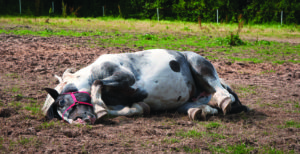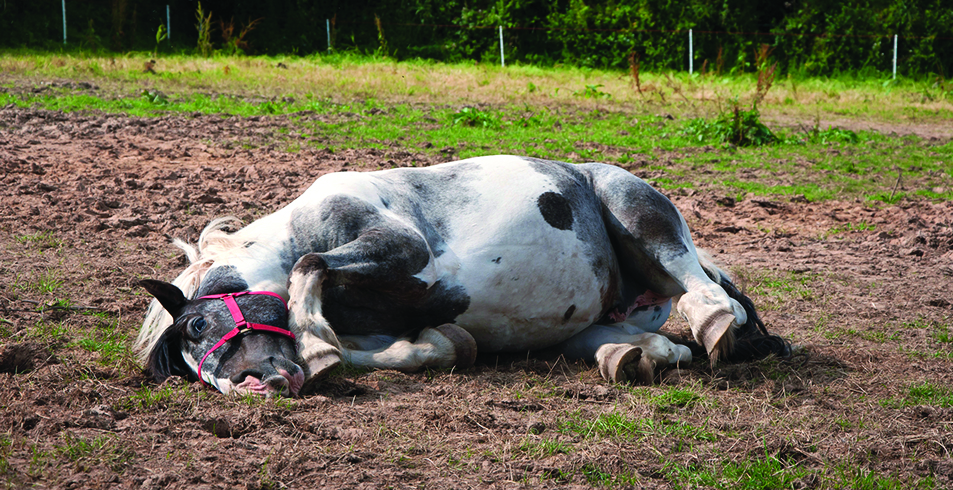Knowing the Symptoms and Risk Factors Could Save Your Horse
by Dave Sauter, DVM
 Colic simply refers to abdominal pain. Horses seem to have more problems with colic than any other domesticated animal; it is the leading cause of death over any other equine disease. One study found an incidence of 4-10 cases per 100 horses in one year, with a fatality rate of 6-7%. In addition to the emotional impact colic has on horse owners, the monetary loss related to the treatment, loss of use, and loss of life is substantial. As horse owners everywhere are keenly aware, colic in horses is a big concern.
Colic simply refers to abdominal pain. Horses seem to have more problems with colic than any other domesticated animal; it is the leading cause of death over any other equine disease. One study found an incidence of 4-10 cases per 100 horses in one year, with a fatality rate of 6-7%. In addition to the emotional impact colic has on horse owners, the monetary loss related to the treatment, loss of use, and loss of life is substantial. As horse owners everywhere are keenly aware, colic in horses is a big concern.
Many causes of colic in horses range from mild to life threatening. The level of pain can correlate with the severity of the problem, but not always, because individual horses differ in their tolerance to pain as well as how they react to it.
There are a wide range of symptoms to colic. The subtlest symptom is simply loss of appetite, more commonly known as being “off feed.” Horses are eating machines. In the wild, horses spend 16 hours a day eating, therefore a horse that is off feed is a reason for concern.
Tense facial expressions, tight lips, frequent yawning and curling of the upper lip (known as flehmen) can also be signs of colic. As the intensity or reaction to pain increases, other clearer signs of colic may appear including the following: looking at their sides or kicking at their belly, pawing the ground, tight abdominal muscles, as well as drawing the abdomen upward.
Some horses with colic will lie down quietly but at uncharacteristic times or places. As pain intensifies, horses will be up and down, frantic to do something to react to the discomfort. Rolling is another sign that the pain is severe. In very extreme colic, the horse might be unwilling or unable to stay up on its feet, violently throwing itself to the ground, rolling uncontrollably, unable to tolerate the extreme pain. Marked sweating and self-injury can occur when things get this bad.
Fortunately, about 80% of colics are relatively simple problems such as gas, gut spasms, or mild impactions. These problems generally present with the milder signs described above and respond to medical therapies such as pain medication, nasogastric tubing with fluids, electrolytes, laxatives, lubricants and intravenous fluids. Untreated, some simple colics can progress into more serious problems.
Some colic cases are severe problems from the start and may require surgery in order to correct the problem. Surgical colics might need and benefit from medical therapies, but ultimately the horse will not survive without surgical intervention.
Here are some do’s and don’ts when you think your horse is colicky:
- Don’t get hurt – a horse in violent pain takes no regard for its own safety, let alone yours. You won’t be much help to your horse if you get injured.
- If it is safe and the symptoms are mild, take your horse for a walk. Distraction from mild pain, the rhythm of walking and encouraging gas to pass can help some milder colic cases resolve.
- If the pain is more severe, do try to keep the horse moving but don’t put yourself in danger.
- Don’t give Banamine unless your veterinarian tells you to do so. Banamine is a powerful prescription pain medication which can mask the pain of more serious causes of colic, delaying the veterinary intervention that is ultimately necessary. Banamine will have better effect when given intravenously by your veterinarian.
- Do call your veterinarian for advice. Veterinarians generally are very accessible and generous in providing assistance over the phone.
- Do get your veterinarian out if it is clear that the pain is extreme.
- Do get your veterinarian out if the pain is mild but the horse is not getting better.
- Be aware of the factors that increase the risk of colic:
- Rough, poor quality forage can lead to impaction colic.
- Poor dentition leads to poor chewing, the first step in digestion. Provide regular dental care.
- Parasites damage the digestive tract and compromise digestive function. Have regular fecal exams checking for parasite loads and deworm appropriately
- Access to water – provide access to clean fresh water. In the winter, provide access to tepid water at least a couple times a day and horses will drink more.
- Grain overload leads to colic and laminitis. Secure stall doors and keep feed secure from horses that might get loose. Avoid large grain meals but feed more, smaller amounts
- Lush spring pastures lead to gut flora changes, greater gas production and colic. Limit access to spring pasture, use grazing muzzles to slow pace of consumption
- Change—whether it’s weather, moving to a new location, new horses on the property, feed change, turn out schedule – is a risk factor for colic. Do what you can to mitigate the stress from the change, such as making changes gradually.
I’ve often wondered why horses have so much more problem with colic than other animals. Perhaps it has to do with how we’ve bred them over the centuries—to be fast, athletic, and powerful —that has not suited their digestive health so well. Whatever the reason, colic is worrisome for all horse owners. We should do all we can to prevent it. Still, even in the best managed farms we can’t control everything and colic can still strike.

Dave Sauter is a Minnesota native and graduated from the University of Minnesota in 1987. Following graduation he interned at Rood and Riddle Equine Hospital in Lexington, Kentucky. After this internship, he continued to work exclusively with horses for another five years in Kentucky before moving out West and joining Kulshan Veterinary Hospital in Lynden, WA. He is a member of the AAEP, AVMA and the WSVMA. For more information about Kulshan Veterinary Hospital call 360-354-5095 or email drkulshan@msn.com. www.KulshanVet.com

